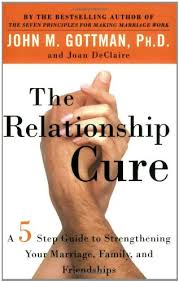
Theory, research and deep understanding are all very well and good. If attachment theory is the ball, many therapists have run with it, but few have scored touchdowns in the form of accessible, practical, how-to-fix-it user manuals such as those produced by the Gottman team.
The brilliance of these scientists has been to use their one-of-a-kind observation skills to dissect the minutiae of ordinary, daily communication. With the precision of a Linnaeus or a Darwin, they recorded thousands of routine interactions that make up the bulk, time-wise, of any relationship. Then they analyzed these seemingly insignificant mini-conversations. These hours of mundane exchanges and the electrical signs of emotional calm or upset (the couples were hooked up to devices that monitored physiological arousal) form the basis of this excellent guide on how to interact with friends, lovers, family and coworkers.
Step One: Look at Your Bids for Connection
The Relationship Cure devotes the first three chapters to defining so-called “bids for connection” and providing pointers on how to issue and respond to them. Forget the big talks about existential questions. According to the authors, “A bid can be a question, a gesture, a look, a touch – any single expression that says, I want to feel connected.” This theory holds that how we answer a request to pass the salt is as crucial as deep talk, and the buildup of these thousands of small interactions determines the success or failure of our relationships with spouses, family, friends and colleagues.
Consider romance. If you think it requires repeat declarations of passion, loyalty and love, think again. A grunt of acknowledgment, or lack thereof, when one partner comments that the sky looks cloudy tells the tale of how this marriage will evolve. This is the communication that counts.
The book provides examples in professional and family relationships. In a marriage, “Turning Toward” might take this form: Spouse A says, “Look at that antique car!” Spouse B looks, grunts, says “Yeah.” If Spouse B replies, “What do you know about antique cars,” that would be Turning Against. If Spouse B doesn’t bother to look, that would be Turning Away.
Happily married couples may engage in these bids 100 times in ten minutes during a typical dinner conversation – but couples headed for divorce only 65 times. Multiply this by the thousands of occasions for connection during a year, and it becomes clear that bids are money in the bank and provide a cushion for the inevitable moment when differences arise.
When men fail to respond to bids, the chances are they’re being mindless, according to the book. When women fail to respond, they are aware of their withdrawal. But whether intentional or not, over time both situations will have equally devastating consequences to the marriage.
Gottman says people who have trouble with the bidding process tend to have difficulties in many areas in life – work, friendships, family, not just love. But take heart, because it’s a skill that can be improved upon. And the authors liberally sprinkle the book with examples of bids issued and received, of how-to and how-NOT-to issue and respond to bids in love, work, friendship, and even parent-teenager interactions.
[An aside from me, not the book: What if it’s harder to turn toward someone when our brain has been altered by synthetic heroin for pain, speed masquerading as an attention regulator, anti-depressants, and even excess insulin produced by people who ingest too many sugars, either from alcohol or junk food? What if when we’re flooded with these chemicals it’s much easier to “turn away”? What if, in the case of the classic mean drunk, there’s something in alcohol that makes it easier to “turn against”?
Scientific American wrote that in 2013, one is six Americans was taking a psychiatric drug; according to the CDC, between 2011 and 2014 almost 49% of Americans had taken a prescription drug within the past 30 days, and in 2012 more than 259 million opioid prescriptions were written. What kind of “turning away” does that produce?]
Step Two: Discover Your Brain’s Emotional Command Systems
This focuses on the neurological truth underlying Whitman’s observation that we contain multitudes. Gottman says the differences in our overall personalities are due in part to preferences aboutYou which of our “mini” personalities we prefer to stimulate.
Research has identified the brain structures for seven systems that exist in all mammals, which indicates that we have been wired this way by evolution.
Males show more development with the Commander-in-Chief, the Sentry and Jester systems. Women have more highly developed Nest-Builders, the part that controls affiliation, bonding and attachment. The other systems are the Explorer, the Energy Czar and the Sensualist.
There is a self-test, followed by pages of examples of how people who prefer different activation levels of different systems can misunderstand each other and fail in bids. This section aims to help us understand better which systems are more activated in friends, family, partners and colleagues and shows us how to handle bids for connection with different types.
Step Three: Examine Your Emotional Heritage
What if you receive an email from the boss saying he needs to discuss something with you. Would you react with fear and defensiveness, a result of being brought up in an environment where authority figures were harsh or capricious? Or with excitement, because you assumed the boss needed your help or was going to offer a new assignment? A lot depends on experiences in the family of origin, and many of our reactions today have nothing to do with the present situation in which we find ourselves, but instead are knee jerk emotional responses to events of long ago.
Then comes discussion of the four broad family styles of dealing with emotion.
Coaching: These families believe that all emotions are acceptable and teach their children to express them in acceptable ways. These families turn towards one another’s bids.
Laissez-faire: Like the coaching kind, these parents have no trouble with the expression of emotion, but may not know how to set limits, such as reining in a child who is acting out with violence.
Dismissive: You were discouraged from showing negative feelings, and if you did, you were greeted either with silence or with a minimizing comment such as, “Someone your age shouldn’t be crying.”
Disapproving: These families take it one step further by reacting with hostility towards the expression of emotion. “Stop crying or I’ll give you something to cry about” or “Say something nice or don’t say anything at all” might be words you remember from this kind of upbringing.
[This chapter was very revealing. I was certain I would fall into the coaching category, but some of the examples of dismissive and disapproving were me to a T, even though at the time I thought such behavior was helpful.]Step Four: Sharpen Your Emotional Skills
This chapter deals with reading others’ emotions via facial expressions, body language and gestures, touch, and vocal inflections, and provides exercises on how to sharpen our skills in those areas. A section on putting feelings into words notes that some of us have a rich vocabulary and are aware of our emotions moment to moment, but many are not. According to other research that I’ve read, emotions arise in the limbic area of the brain, which they say is visual and not verbal, and that means that some of us will need to spend time actually thinking about what we’re feeling and will have to put some effort into matching up the correct word with our emotions. There is also a section on metaphors, or the art of sussing out someone’s interior life by listening to his or her choice of words. (This is echoed in the 2016 bestseller It Didn’t Start with You: How Family Trauma Shapes Who We Are and How to End the Cycle, by Mark Wolynn. The authors also reference Metaphor Therapy: Using Client-Generated Metaphors in Psychotherapy, 1995, by Richard Kopp.) Lastly, there is a page on the direct proportion between the amount of television we watch and “indicators of discontent” such as troubles in relationships and other areas of life.
Step Five: Find Shared Meaning
The current U.S. political climate, with the country divided into what might as well be two nations, is a perfect opportunity to put this advice into practice. Even the most diehard political opponents might share the same views on child-raising, the same hobbies and the same taste in music. Find the commonalities, is the advice, and build the relationship from there. As for spouses, Gottman believes that most conflict develops “because people attach different meaning to the same situation, which gets in the way of their ability to bid and respond to one another’s bids for connections…. They are idealists who choose to take different stands based on different understandings of what things mean…. But if they can keep talking and describing how they find meaning in their positions, they may reach some common ground… “
The sidebar here is that we can form more positive emotional connections when we become a “dream detector,” or when we encourage one another’s dreams and aspirations.
My Conclusion
Some of the exercises seemed similar to those my daughter recalled from her days at a prestigious acting conservatory. For example, a simple sentence can broadcast different meanings depending on the tone of voice and other accompanying non-verbal messages. Practicing these exercises heightens our awareness of what we’re communicating. In fact, one could say that Gottman’s purpose is to increase communications skills, aka our self-awareness, aka our awareness in how we affect others. In this age of increasing isolation, with a greater than ever share of our precious hours spent in front of TV, computer or cell phone, our children reach adulthood with fewer of these skills, we as adults fail to nurture these skills in ourselves, and then, hurt and confused by the consequential failures in relationships, we retreat further into our isolation in front of those very same screens. Wouldn’t it be great to replace this with a virtuous cycle? The Gottman books hold out this hope. Buy them, and do the exercises. Join or start a meetup group to practice them.

Recent Comments